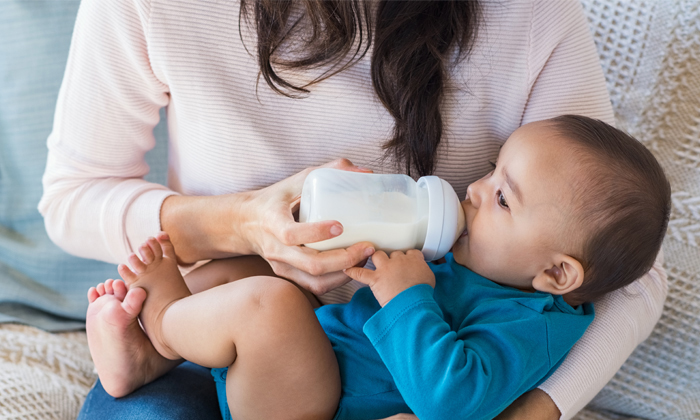Breast milk sugars can protect babies from deadly diarrhoea
- Like
- Digg
- Del
- Tumblr
- VKontakte
- Buffer
- Love This
- Odnoklassniki
- Meneame
- Blogger
- Amazon
- Yahoo Mail
- Gmail
- AOL
- Newsvine
- HackerNews
- Evernote
- MySpace
- Mail.ru
- Viadeo
- Line
- Comments
- Yummly
- SMS
- Viber
- Telegram
- Subscribe
- Skype
- Facebook Messenger
- Kakao
- LiveJournal
- Yammer
- Edgar
- Fintel
- Mix
- Instapaper
- Copy Link
Posted: 28 June 2019 | Andy Extance | No comments yet
Jennewein Biotechnologie discusses the importance of adding human milk oligosaccharides (HMOs) to infant formula to better emulate the benefits of breast milk.


In the late 19th century, scientists made the vital discovery that breast-fed infants suffered less often from killer ailments like infectious diarrhoea – but the reason why eluded them. At the time up to three children in ten died before they reached a year old. There must have been something about human milk, because breast-fed children had a much higher chance of survival and had lower incidences of many diseases than bottle-fed infants.
Today we know that sugar-based molecules, known as human milk oligosaccharides (HMOs), help us resist the pathogenic bacteria that drive diarrhoea in many ways, some of them unique. As such HMOs, both in natural breast milk and added to infant formula, can help reduce the suffering diarrhoea causes children.
19th century microbiome
But in 1886, Austrian pediatrician and microbiologist Theodor Escherich’s discovery of the relationship between infants’ intestinal bacteria and their digestion was a revelation.1 In effect, he was talking about our gut microbiome, the concept so central to much health science, decades before the term was even coined. Within 15 years, other scientists had found that the bacteria in babies’ poop differed according to whether they were breast-fed or not.2,3
Then these scientists’ successors found that human milk is what we would now call a prebiotic – it promotes the growth of beneficial bacteria such as several bifidobacterial species 4 This is partly due to the unique sugar molecules found in human milk.
Building resistance
Sugar molecules can link together like building blocks. In the most familiar example glucose and fructose connect together to make sucrose. Starch is also formed from long chains of glucose, while an oligosaccharide contains just a few building blocks. There are five building blocks available to HMOs, and they link together in an impressively diverse range of combinations.5 About 200 structural divers HMOs are known today. The concentration of HMOs in human breast milk ranges from about 25 g/L in the colostrum to 5 g/L in mature milk. By contrast, the concentration of oligosaccharides in cows milk is much lower and the sugars mostly do not resemble those in human milk
HMOs’ prebiotic action can suppress more harmful bacteria, such as Campylobacter jejuni, one of the most common causes of bacterial diarrhoea. According to the World Health Organisation (WHO), Campylobacter species are one of the four key global causes of diarrhoeal diseases and is considered to be the most common bacterial cause of human gastroenteritis in the world. But HMOs also help fight it in another, more specific way. C. jejuni recognises and grabs onto sugar chains on the outside of the gut cells. The HMO sugar chains look very similar to those on gut cells, similar enough to serve as decoys.
Going viral
The same effect also helps fight diarrhoea-causing viruses such as rotaviruses and the famous noroviruses, which together cause almost half a million deaths annually. Recent WHO estimates suggest that norovirus alone kills over 200,000 people each year, more than 50,000 of them children. Like C. jejuni, these viruses grab onto sugar chains found on gut cells. Unlike C. jejuni, the viruses then force their way inside the cells, where they use the protein machinery they find to reproduce themselves.
If an infant has fed on human milk, instead of grabbing onto their receptors on the epithelial cells, the so called histo-blood group antigens 6, noroviruses and rotaviruses bind to the HMOs and flushed out of the human body. Blocking the binding of the viruses to their receptors makes it a lot less likely that the viruses can enter the cells, reproduce themselves and spread further.
And experiments do show that HMOs can speed recovery from viral diarrhoea, likely from a combination of the prebiotic and decoy effects. For example, piglets fed on baby formula milk alone take around 80 hours to recover from diarrhoea caused by rotaviruses.7 Those fed with formula including HMOs recovered in around 53 hours.
Scientists have found one other means through which HMOs can help fight illnesses like diarrhoea. They can indirectly affect the immune system, increasing levels of white blood cells, for example. However, researchers don’t yet know exactly which HMOs affect which immune system molecules in driving such effects.
Sugar role
Research in humans has shown that HMOs that contain a sugar building block called fucose are especially potent at fighting C. jejuni. Scientists have shown that such molecules help reduce episodes of C. jejuni-associated diarrhoea in almost 100 mother–infant pairs in a study in Mexico City.8 Infants whose mothers’ milk contained high concentrations of an HMO including fucose, called 2’-fucosyllactose or 2’-FL, suffered from C. jejuni diarrhoea significantly less often. Infants of mothers whose milk contained high levels of a different fucose-containing HMO also suffered from diarrhoea caused by calicivirus less often.
As this study shows, mothers’ ability to make 2’-FL and other fucose-containing HMOs can vary, which is due to genetic factors. Making HMOs requires specific genes, which carry the instructions to produce enzymes that link together sugar building blocks in the right way. Nearly a quarter of the US population have genetic makeups that prevent them from making HMOs containing fucose that is specifically linked to other sugar building blocks.9 These mothers, so called non-secretors have a HMO profile that is different from that of secretor mothers which have large amounts of 2’FL in their milk. However, their gut cells also lack the similar molecules that rotaviruses grab onto, meaning that they’re less likely to suffer from diarrhoea.10,11 They may also pass this benefit onto their children.
Human milk without a mother
Nevertheless, HMOs could serve as either therapeutics to treat current infections or prophylactics to prevent infection. For instance, children at risk for diarrhoea could take HMO antimicrobial cocktails. But getting HMOs is difficult, as donor milk supplies are limited, which once hampered both research and commercial prospects. The limited supplies also made identifying which exact HMO molecules have beneficial effects very difficult.
Making HMOs using biotechnology has overcome these limitations, and Jennewein Biotechnologie is a leader in this area. Using a fermentation process, the company exploits genetically-engineered microorganisms to produce these sugars. Jennewein is the first company to make 2’-FL this way, gaining market approval from the US Food and Drug Administration (FDA) for use in infant and toddler nutrition in 2015. The following year, the first infant formula product including Jennewein’s HMO reached the US market. And then, in 2017, Jennewein’s 2’-FL was approved in the European Union. Today it is available in select European countries, and supplements baby nutrition in many countries around the world.
Diminishing diarrhoea’s deadliness
For the privileged amongst us – which likely means everyone reading this – it might be strange to think that diarrhoea can be deadly. But it remains the case. According to WHO estimates from 2013 about 215,000 children aged less than 5 years old die each year from rotavirus infections, and the vast majority of these children live in low-income countries. Thanks to scientists like Theodor Escherich and his successors, we now know that breast milk can be a powerful weapon in fighting back against the germs responsible. But when even more help is needed, biotechnologically-made HMOs like Jennewein’s could be invaluable.
References
- Escherich T. 1886. Die Darmbakterien des Säuglings und ihre Beziehungen zur Physiologie der Verdauung. Enke Verlag: Stuttgart.
- Moro E. 1900. Morphologie und bakteriologische Untersuchungen über die Darmbakterien des Säuglings: Die Bakterien-flora des normalen Frauenmilchstuhls. Jahrbuch Kinderh. 61:686–734.
- Tissier H. 1900. Recherches sur la flora intestinale de nourissons (état normal et pathologique). Paris, France
- Schönfeld H. 1926. Über die Beziehung der einzelnen Bestandteile der Frauenmilch zur Bifidusflora. Jahrbuch Kinderh. 113:19–60.
- Bode L. 2012. Human milk oligosaccharides: Every baby needs a sugar mama. Glycobiology, 22(9),1147-1162. DOI: 10.1093/glycob/cwc074
- Koromyslova, A., Tripathi, S., Morozov, V., Schroten, H. and Hansman, G. 2017. Human norovirus inhibition by a human milk oligosaccharide. Virology, 508:81-89; DOI: 10.1016/j.virol.2017.04.032
- Li M, Monaco MH, Wang M, Comstock SS, Kuhlenschmidt TB, Fahey GC Jr, Miller MJ, Kuhlenschmidt MS, Donovan SM. 2014 Human milk oligosaccharides shorten rotavirus-induced diarrhea and modulate piglet mucosal immunity and colonic microbiota. ISME J. 8:1609-20; DOI: 10.1038/ismej.2014.10
- Morrow AL, Ruiz-Palacios GM, Altaye M, Jiang X, Guerrero ML, Meinzen-Derr JK, Farkas T, Chaturvedi P, Pickering LK, Newburg DS. 2004. Human milk oligosaccharides are associated with protection against diarrhea in breast-fed infants. J Pediatr. 145:297–303; DOI: 10.1016/j.jpeds.2004.04.054
- McGuire, M., Meehan, C., McGuire, M., Williams, J., Foster, J., Sellen, D., Kamau-Mbuthia, E., Kamundia, E., Mbugua, S., Moore, S., Prentice, A., Kvist, L., Otoo, G., Brooker, S., Price, W., Shafii, B., Placek, C., Lackey, K., Robertson, B., Manzano, S., Ruíz, L., Rodríguez, J., Pareja, R. and Bode, L. 2017. What’s normal? Oligosaccharide concentrations and profiles in milk produced by healthy women vary geographically. Am. J Clin. Nutr., 105:1086-1100; DOI:10.3945/ajcn.116.139980
- Bustamante, M., Standl, M., Bassat, Q., Vilor-Tejedor, N., Medina-Gomez, C., Bonilla, C., Ahluwalia, T., Bacelis, J., Bradfield, J., Tiesler, C., Rivadeneira, F., Ring, S., Vissing, N., Fink, N., Jugessur, A., Mentch, F., Ballester, F., Kriebel, J., Kiefte-de Jong, J., Wolsk, H., Llop, S., Thiering, E., Beth, S., Timpson, N., Andersen, J., Schulz, H., Jaddoe, V., Evans, D., Waage, J., Hakonarson, H., Grant, S., Jacobsson, B., Bønnelykke, K., Bisgaard, H., Davey Smith, G., Moll, H., Heinrich, J., Estivill, X. and Sunyer, J. 2016. A genome-wide association meta-analysis of diarrhoeal disease in young children identifies FUT2 locus and provides plausible biological pathways. Hum. Mol. Genet., 25:4127-4142; DOI: 10.1093/hmg/ddw264.
- Currier, R., Payne, D., Staat, M., Selvarangan, R., Shirley, S., Halasa, N., Boom, J., Englund, J., Szilagyi, P., Harrison, C., Klein, E., Weinberg, G., Wikswo, M., Parashar, U., Vinjé, J. and Morrow, A. 2015. Innate Susceptibility to Norovirus Infections Influenced by FUT2 Genotype in a United States Pediatric Population. Clin. Infect. Dis., 60:1631-1638; DOI:10.1093/cid/civ165









